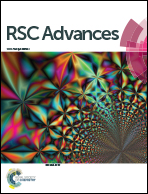l-Ascorbyl 2,6-dipalmitate inhibits biofilm formation and virulence in methicillin-resistant Staphylococcus aureus and prevents triacylglyceride accumulation in Caenorhabditis elegans†
Abstract
In the present study, the antibiofilm, antipathogenic and anticarotenogenic potential of L-ascorbyl 2,6-dipalmitate (ADP) against methicillin-resistant Staphylococcus aureus (MRSA) has been evaluated. ADP inhibited biofilm formation by MRSA in a concentration-dependent manner. Light and confocal laser scanning microscopic analyses further confirmed the potent antibiofilm activity of ADP. Furthermore, ADP treatment inhibited virulence factors without any influence on the growth/metabolic activity of MRSA. ADP treatment also affected the survival of MRSA in the presence of hydrogen peroxide, methylene blue and whole blood, and modulated the expression of genes involved in biofilm formation and virulence. The combination of ADP with antibiotics efficiently protects Caenorhabditis elegans from MRSA infection. Compounds that inhibit staphyloxanthin synthesis are known to inhibit triglyceride accumulation in eukaryotes. Hence in the current study, the anti-obesity potential of ADP was also evaluated using the model nematode C. elegans. The results revealed the ability of ADP to mitigate triacylglyceride accumulation without affecting food consumption or reproduction. FTIR analysis also confirmed the reduction of fat accumulation. qPCR analysis revealed the ability of ADP to interfere with the expression of genes involved in fatty acid synthesis and insulin signalling. In addition, molecular docking analysis predicted the ability of ADP to interact with proteins involved in staphyloxanthin and oleic acid biosynthesis and stearoyl-coenzyme A desaturase-1 in MRSA, C. elegans and humans, respectively. The results obtained in the present study suggest that ADP could be utilized as a potent antipathogenic and anti-obesity agent.



 Please wait while we load your content...
Please wait while we load your content...